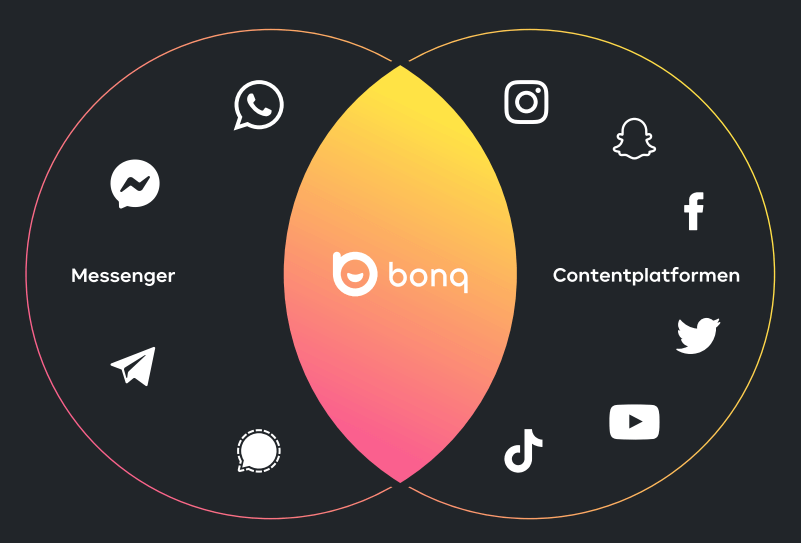I want to share with you the most comprehensive entrepreneurial journey I have ever undertaken. bonq is an app I developed with UI designer Tien Nguyen from August 2021 to June 2022.
bonq - Share unique emotions with your friends
Every day people react with real emotion to memory photos, memes or funny videos. Until recently, this bonq moment only took place in person, as the reaction via Messenger is often text-based and emotionally reduced. With the bonq app, you can share your favourite memes and memories and capture immediate, authentic and emotional reactions from your friends in the form of a video:
🤳🏻 Send a bonq
When you find a photo or video that reminds you of your friends, send it to them via bonq. TikToks etc. can also be imported directly into bonq via the native share menu.
✨ Spark curiosity
Your friends receive the content blurred at first. When they click on it, the blur is removed and their first, unique, authentic emotion is recorded.
🤩 Capture emotions
The reaction is sent back to you, adding an emotional dimension to the content and available in your bonq collection so you can relive those moments anytime.

Developing bonq
Design Thinking
To make the potential users empirically comprehensible, I worked with different design thinking methods. First, I identified fictitious “personas”, i.e. a prototype for a group of users. Then, based on this persona, I created various “customer journey maps” to visualise the steps the user has to go through when using the product. These methods helped me to formulate concrete user stories, from which I finally derived the functions of the app and identify the target group of bonq, which is people of Generation Alpha and Z (13-25 years old), who use many social media platforms in their daily lives and with varying frequency send each other digital content via Messenger.
User Tests
After creating an MVP and in order to validate the findings and hypotheses, I planned and carried out several out-loud user tests. A user test always required two people, ideally two who already knew each other. The people talk out loud about what they see/think and send some bonqs back and forth to each other. Afterwards, a survey was answered to get more detailed insights on relevant questions. The results of these user tests were factored into the design of the final product.
Implementation
To get to market quickly and iterate on all platforms, I used a cross-platform stack. I write only one code base to make bonq available as an app in modern browsers and in the Apple and Google app stores. This allows me to get the maximum reach from day one.
A rough sketch of the app tech stack: Angular as the front end framework; Ionic Capacitor for native UI components and APIs; Web Assembly and Tensorflow for Face Recognition API; Supabase, AWS, NestJS and Firebase as the back end.

Business plan
bonq is both a content and messaging platform that also serves the hype topic of reactions. bonq operates in a market with a total potential of 500 billion US dollars. The business model is primarily based on ads. Other sources of revenue are freemium models and ApiFees. With an user base the size of Jodel, another German social medium, 7.5 million users can generate 4 million euros in revenue per year.

Learnings
Two brains are smarter than one. And if you want to go fast, go alone, but if you want to go far, go together. I’ve been programming since my teens, so I’m quite capable of developing an app. In my undergraduate degree, I learned how to do the design thinking process for a product and how to build a business around it. However, without the help of Tien’s ideation and design skills, bonq wouldn’t be what it is today. Find a capable co-founder!
Developing code should take the same amount of time as developing a good marketing strategy. The next time I build a project, I’ll split my time 50/50 between marketing and coding. Now it was more like 90/10.
I’m not the same programmer I was before this project. I’ve learned how to build scalable, low-cost systems, manage a lot of data, keep it in sync and available offline. All while I’ve touched pretty much every web api out there and covered all the edge cases for the various platforms (I’m looking at you, Safari iOS). I could write an entire book on the architecture and algorithms that went into the development of bonq.
At the first pitch, we were very confident, but we were overwhelmed by questions that we hadn’t thought through. For example, “How is Snapchat different?”. The first pitch was a real motivation killer. But it also helped us prepare answers to those questions and shape bonq’s identity. We revised our pitch, answered all the questions, and presented it to an accelerator. And they wanted us to be part of it! I think we had to really mess up first to finally learn how to do the bonq pitch. Our biggest was at the Startup Summer Slam Festival 2022 in front of a few hundred people.

You have to have a niche. Social media is not a very good niche to reach a target audience. My social media bots can only do so much to generate traffic. If there are no hashtags or influencers in a niche to target, even black hat marketing won’t do much. And I think that’s the main reason why it’s so difficult for bonq to take off. Social media is not a niche.
There’s a lot of support out there. Whether it’s workshops, funding, cloud credits, mentorships, platforms to pitch. Just find your next accelerator and scholarships.
And finally. As great as the challenge may be at the beginning.
One step at a time. If you keep going, everything will fall into place, and you will learn a lot, at least.
You can do the thing!

